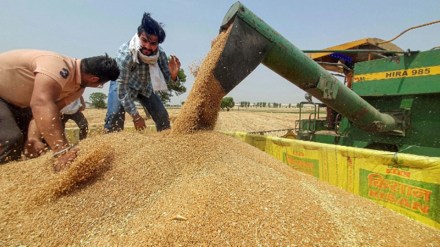A year ago, the Centre was bullish about a bumper wheat output, achieving record procurement, and around 10 million tonne (mt) of exports in the current fiscal, sensing the global opportunity arising out of the Russia-Ukraine conflict. The scenario has changed sharply, with retail inflation in wheat at 25% this January. Sandip Das takes a look
The wheat harvest picture
Global wheat prices rose sharply because of the Russia-Ukraine conflict as both countries play an important role in the trade of the grain. Sensing an opportunity for exports, the Centre announced that 10 mt of wheat will be exported in 2022-23. While a record output was expected in the 2021-22 season (July-June), the standing crop suffered because of excessive rain in the middle of March last year, just prior to the harvesting season, resulting in shrivelled grain. Due to lower production and higher global demand, FCI’s procurement in the 2022-23 marketing season (April-June) fell over 56.6%, to just 18.8 mt, against 43.3 mt the year before. Sensing supply constraints, the Centre banned exports in May, except to meet food security needs of other countries.
Also read: FM: Will allot more funds for rural jobs scheme if needed
Did the ban on exports ease the domestic supply situation?
While the agriculture ministry had estimated that wheat production in the 2021-22 crop year (July-June) had declined marginally to 107.7 mt, from 109.6 mt in the previous year, trade sources say that production losses due to the heat wave in March last year has been significant; the actual production is estimated to be around 99 mt. Prior to the ban on wheat shipments in May, India had exported more than 2 mt of the grain in the current fiscal because of robust global demand. During April-December (2022-23), 4.6 mt of wheat has been exported and the government has banned shipment of flour (atta) and other wheat products. However, retail inflation for the grain has been rising consistently, from 11.73% in July 2022to 25% in January 2023.
Rising prices
As per government data, the modal retail price of wheat and flour on Friday rose to Rs 28/kg and Rs 35/kg, from Rs 22 and Rs 28 six months ago. Traders say private supplies are running low, and because of the delay in the approval of sale of FCI’s stock in the open market, the supply situation would be tight at least till the end of this month as it takes 3-4 weeks to process wheat and supply flour.
Prospects for crop year 2022-23
Wheat has been sown in 34.3 million hectares this season (2022-23), which is marginally higher than the previous year. The second advance estimate of foodgrain production for the 2022-23 crop year (July-June) pegs the wheat output at a record 112.18 mt. While some harvests of the crop—early-sown varieties in pockets of Gujarat and Madhya Pradesh—have started to arrive in the mandi, harvesting in most areas will commence from the middle of next month.
What the government is doing to bring down wheat prices
To cool down the sharp spike in wheat as well as atta prices, the government, since the beginning of February, has decided to sell 3 mt of wheat from the FCI’s stock in the open market. In the two e-auctions held so far, 1.4 mt of wheat has been sold to bulk buyers such as food companies and flour millers.
Also read: Draft norms on lending of govt securities issued
The government has also asked states to purchase 0.5 mt of wheat to be distributed through its own network, besides asking agencies such as NAFED, NCCF and Kendriya Bhandars to sell wheat at Rs 21.50/kg from Friday.
The key aim is to reduce the retail prices of wheat that is currently ruling at around Rs 2,300/quintal-Rs 2500/quintal to the level of the minimum support price (MSP)—Rs 2125/quintal—announced for the 2023-24 marketing season (April-June). This will ensure that the FCI and state agencies which would officially start procurement from April 1 get sufficient grain to purchase. The government is exploring options such as imposing stock-holding limits for wheat as well. Climbing wheat prices have also put pressure on the RBI—the consumer inflation print in January has made pausing rate-hikes seem more difficult than 0before.
